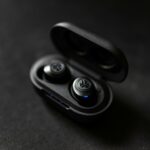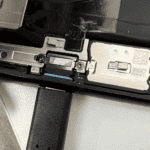Water can seriously harm your iPhone. Many users wonder how to tell if their device has been affected. Fortunately, Apple has built-in a simple way to check. iPhones have Liquid Contact Indicators (LCIs) that change color when exposed to water.
These tiny indicators are hidden from view. They’re usually white or silver. But they turn red if they touch water. This helps Apple technicians spot water damage quickly. It’s useful for warranty claims too.
Knowing how to find and read these indicators is valuable. It can save you time and money. You’ll know if water is the cause of your iPhone issues. This knowledge helps you decide whether to seek repairs or try drying methods first.

What Is the Water Damage Indicator (LCI)?
Apple installs a Liquid Contact Indicator (LCI) inside every iPhone and iPod model.
This small strip or dot is designed to change color when it comes into contact with water or any liquid containing water.
- Normal (no water exposure): White or silver
- Triggered (water exposure): Bright red or pink
Once the LCI turns red, it means liquid has entered the device, and Apple technicians will recognize this as liquid damage, which voids standard warranty coverage (source: Apple Support).
🔍 Where to Find the LCI on Your iPhone
The location of the LCI depends on your iPhone model.
Here’s a breakdown by generation:
iPhone 12 – iPhone 15 Series
- The LCI is inside the SIM card tray slot.
- Use a SIM ejector tool or paperclip to remove the tray and shine a flashlight inside.
- You’ll see a small white or red dot deep in the slot.
iPhone X – iPhone 11 Series
- Also located inside the SIM card tray slot.
- Same method: remove the tray and inspect the slot’s interior.
iPhone 7 – iPhone 8 Series
- The LCI is inside the SIM tray slot as well.
- On some models, additional LCIs are located internally (not visible without disassembly).
iPhone 5 – iPhone 6S Series
- The LCI is visible inside the SIM card tray slot.
- Some models also have internal indicators near the headphone jack or Lightning port.
iPhone 4 and Earlier
- LCIs are located in two places:
- Inside the headphone jack
- Inside the 30-pin charging port
- These can be seen by shining a flashlight into the openings.
(Sources: Darwin’s Data, WikiHow, Apple Support)
⚠️ What to Do If the Indicator Is Red
If your iPhone’s LCI has turned red, it means liquid exposure has occurred. Here’s what you should do:
- Turn off your iPhone immediately.
Don’t charge or power it on — this can cause short circuits. - Remove any accessories.
Take out the SIM card, case, and unplug cables. - Gently dry the device.
Wipe the exterior with a soft, lint-free cloth.
Do not use heat (like a hair dryer) or insert objects into ports. - Let it air-dry for at least 24–48 hours.
Place it in a dry, ventilated area. Avoid using rice; instead, use silica gel packets if available. - Check for functionality.
After drying, power it on. If it doesn’t respond or behaves erratically, internal damage may have occurred. - Contact Apple Support or an authorized repair center.
Even if the device powers on, corrosion can develop over time, so a professional inspection is recommended.
🧠 Important Notes
- Water resistance ≠ waterproof.
Even IP68-rated iPhones (like the iPhone 13–15) can suffer liquid damage if submerged for too long or exposed to pressurized water (like in pools or showers). - Warranty limitations:
Apple’s limited warranty and AppleCare+ do not cover liquid damage unless you have AppleCare+ with accidental damage coverage (subject to service fees). - LCIs cannot be reset.
Once the indicator turns red, it stays that way permanently — even if the phone dries out.
🧩 Summary Table
| iPhone Model | LCI Location | Visible Without Opening | Color Change |
|---|---|---|---|
| iPhone 12–15 | SIM tray slot | ✅ Yes | White → Red |
| iPhone X–11 | SIM tray slot | ✅ Yes | White → Red |
| iPhone 7–8 | SIM tray slot | ✅ Yes | White → Red |
| iPhone 5–6S | SIM tray slot | ✅ Yes | White → Red |
| iPhone 4 & earlier | Headphone jack + 30-pin port | ✅ Yes | White → Red |
🧰 Final Tips
- Always remove your phone from water immediately if it gets wet.
- Avoid charging until you’re sure the device is completely dry.
- Consider a waterproof case if you often use your iPhone near water.
- Regularly check your LCI if you suspect exposure — it’s a quick way to spot potential damage early.
Key Takeaways
- iPhones have built-in water damage indicators that change color
- Checking the LCI helps identify if water caused your iPhone problems
- Understanding water damage signs can save time and money on repairs
Identifying Water Damage in iPhones
iPhones have built-in systems to detect water damage. These systems help users and repair technicians know if a device has been exposed to liquid. The key to identifying water damage is understanding how these indicators work and what they show.
Function and Location of Liquid Contact Indicators
Liquid Contact Indicators (LCIs) are small devices inside iPhones. They change color when they touch water or other liquids. LCIs are usually white or silver. But they turn red when wet.
To find the LCI, remove the SIM tray on your iPhone. Look inside the empty slot. You’ll see a small dot. This is the LCI. On some older models, you might find LCIs in other spots too.
iPhone 12 and newer models can handle more water. They can be in up to 19.6 feet of water for 30 minutes. But the LCI will still change if it gets wet.
Interpreting Indicator Color Changes
A white or silver LCI means your iPhone is dry. It hasn’t been in contact with water. If the LCI is red, pink, or orange, it shows water damage.
Sometimes the LCI might look pink instead of bright red. This can mean:
- The device got a little wet
- It was in a humid place
- There was steam nearby
If you see a red LCI, don’t try to charge your iPhone. Let it dry for at least 30 minutes first. Even if it seems to work, there could be hidden damage. It’s best to have it checked by a pro.
Mitigating Water Damage
Quick action is key when your iPhone gets wet. The right steps can save your device from serious harm.
Immediate Steps After Contact with Liquid
Turn off your iPhone right away. Remove it from any liquid contact. Take out the SIM card and tray. Dry the outside with a soft cloth.
Don’t use heat to dry your iPhone. Avoid charging it too. These can cause more damage.
Gently tap the iPhone to get water out of ports. The lightning connector and speakers need special care.
Rice isn’t the best for drying. It can leave dust in your phone.
Using Silica Gel Packets for Moisture Removal
Silica gel packets work well to absorb moisture. They’re better than rice for drying your iPhone.
Put your iPhone in a sealed bag with silica gel packets. Leave it there for 48 hours. This helps pull out hidden moisture.
You can buy silica gel packets online or at craft stores. They’re cheap and effective.
For best results use many packets. Spread them around your iPhone in the bag.
After 48 hours check your iPhone. If it works don’t charge it right away. Wait a few more hours to be safe.
Frequently Asked Questions
Water damage can cause serious issues for iPhones. Here are some key things to know about checking for damage and what to do if your phone gets wet.
How can I check for water damage on my iPhone?
You can check for water damage by looking at the Liquid Contact Indicator (LCI). Remove the SIM tray and look inside the SIM slot. If the LCI is red, your iPhone has water damage. A white LCI means no damage.
What are the repair costs for an iPhone with water damage?
Repair costs vary based on the model and damage. Apple doesn’t cover water damage under warranty. Out-of-warranty repairs can cost $300-$600 or more. Third-party repair shops may offer cheaper options.
Where is the water damage indicator located in different iPhone models?
The LCI location varies by model. For iPhone 12, it’s inside the SIM card slot. Older models may have it in the headphone jack or charging port. Check Apple’s website for your specific model.
Can an iPhone still be repaired after suffering from water damage?
Yes, iPhones can often be repaired after water damage. The chances depend on how quickly you act. Turning off the phone and drying it right away improves the odds. Some damage may be too severe to fix.
What immediate steps should be taken if an iPhone has been exposed to water?
Turn off the iPhone right away. Remove the case and SIM card. Pat it dry with a soft cloth. Don’t use heat or compressed air. Don’t plug it in or press buttons. Put it in a dry place with airflow.
How long should I wait for an iPhone to dry out after being submerged?
Wait at least 48 hours before turning on your iPhone. Some experts suggest waiting up to 72 hours. Apple recommends waiting 30 minutes before charging. Longer is better to ensure all moisture is gone.







